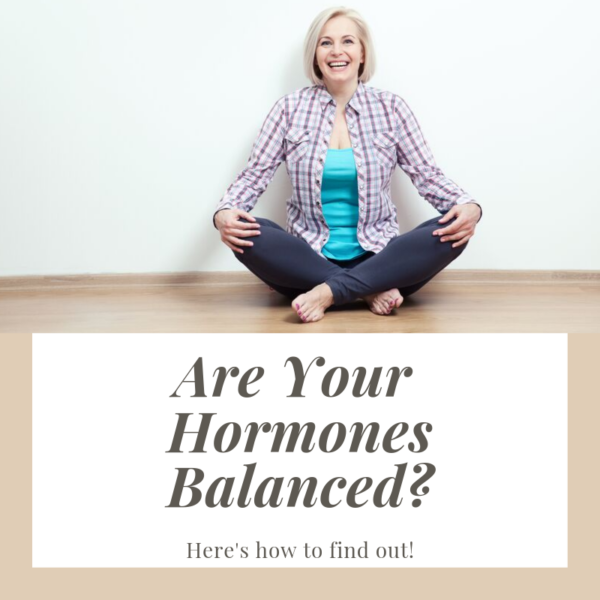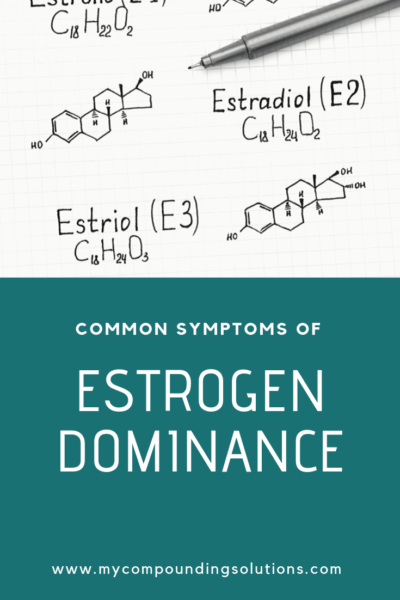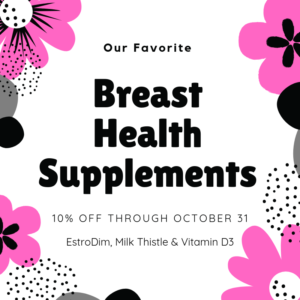
Let’s Talk Estrogen
Estrogen is an important hormone in every woman’s body, it is responsible for over 400 functions! Your Estrogen levels change throughout your menstrual cycle and throughout your life – getting lower as you get older.
There are 3 types of Estrogen in our bodies – Estrone, Estradiol and Estriol. Estrone and Estradiol are considered the stronger Estrogens and Estriol is called the “protective” Estrogen. Each of these is metabolized by your liver and then exits your body.
In an ideal world, your Estrogen and Progesterone levels are in balance. However, as we age we can lean towards having what we call Estrogen Dominance – too much Estrogen in relation to the Progesterone in our bodies. Progesterone is the first hormone to decline in women, beginning in your mid 30s to early 40s.
Estrogen Dominance
When your hormones are balanced, life is good! When they aren’t, they can make you miserable and wondering what happened to the body – and health – you used to have.
There are three types of Estrogen Dominance:
- Excess Estradiol – Quite simply, your body has too much Estradiol.
- Unbalanced hormones – Your Estrogen to Progesterone levels aren’t balanced.
- Ineffective Estrogen detoxification – Your body is recirculating Estrogen and is not getting rid of it normally by detoxing through your liver.
My interest in Estrogen dominance stems from my mom. She is a 2-time Breast Cancer survivor and I now know I have the genetic mutations that make me a slow Estrogen metabolizer which sets my body up for Estrogen Dominance.
Common Symptoms of Estrogen Dominance
Are you experiencing any of these symptoms?
- Heavy bleeding
- PMS
- Depression
- Fibroids
- Endometriosis
- Headaches or migraines, especially before your period
- Anxiety
- Bloating or water retention
- Thyroid nodules
- Irritability / mood swings
- Cellulite
- Fat around your hips
- Lumpy or fibrocystic breasts
- Breast cancer (Estrogen Receptor +)

Common Symptoms of Low Progesterone
Do any of these sound familiar?
- Hot flashes
- Insomnia
- Miscarriages
- Infertility
- Anxiety
- Mood Swings
- PMS
- Irritability
- Heavy periods
The Good News, The Bad News
The bad news? If you do not correct your hormonal imbalance it can increase your risk of breast cancer or give you the above unwanted symptoms.
The good news? There is something – a lot of things actually – you can do!
What Can I Do About It?
Healing Foods
Let’s give a shout out to cruciferous vegetables! These awesome veggies support liver detoxification, they are high in fiber, are anti-inflammatory and help clear the excess estrogen out of your system. Cruciferous vegetables include: broccoli, brussel sprouts, collard greens, kale, cauliflower, radishes and more.
Other great healing foods for hormone imbalance include flax seed, broccoli sprouts, cabbage, pomegranates, turmeric, maca and dandelion.
Supplements
Our three favorite supplements for hormonal balance are Vitamin D3, EstroDim and Milk Thistle. In honor of Breast Cancer Awareness month, we’re offering all three of these 10% off right now (through end of October).

Hormones
If you are low in Progesterone, you can take Progesterone to help balance your hormones. We have an over-the-counter cream or we can compound progesterone in our lab if you have a prescription. Learn more about Progesterone in our recent blog.
In addition to the ideas above, I also recommend checking your hormone levels. You can do this via a saliva test (we have them at our pharmacy) or a blood test through your provider. I also offer hormone consultations where we will discuss your health history, symptoms, hormone levels and goals and come up with a customized strategy for you to get your levels (and you!) back on track. To schedule a consultation, or for more information, give us a call (864-558-0507).
This is an important personal topic for me and I hope this information has been helpful!

![]()
If you enjoyed this post, you may also enjoy:
10 Self Care Practices for a Healthy You